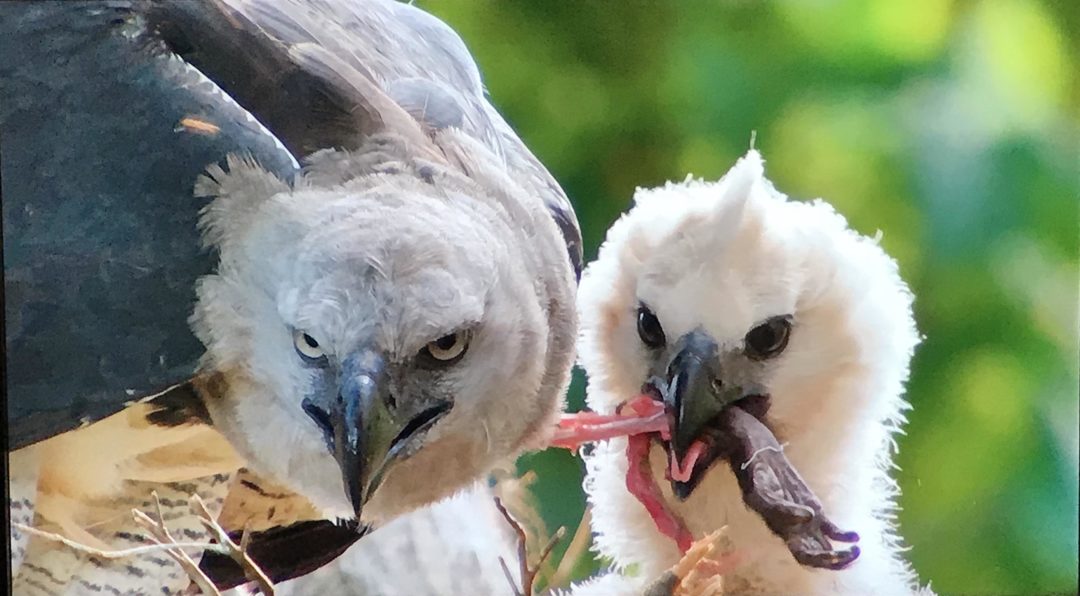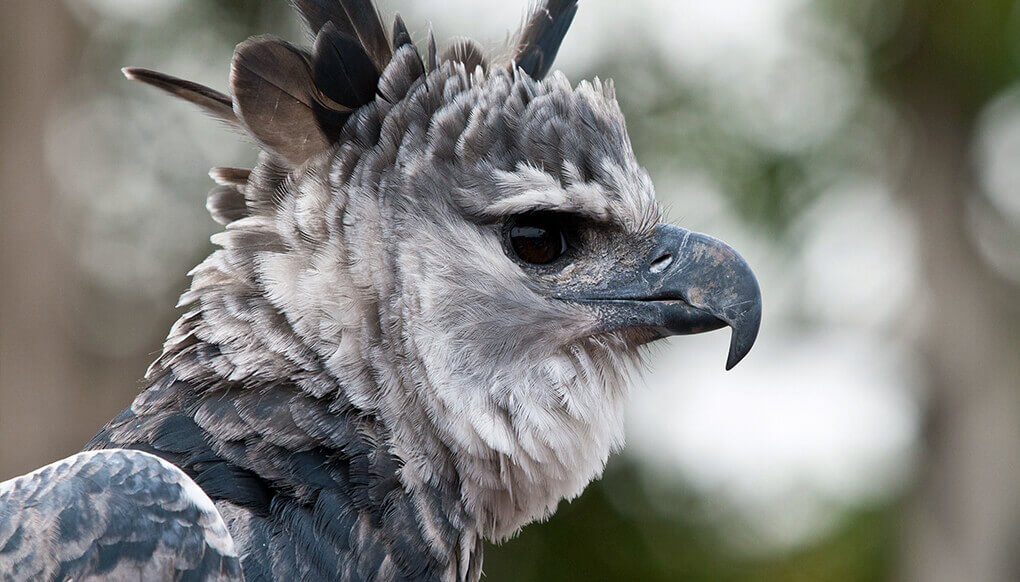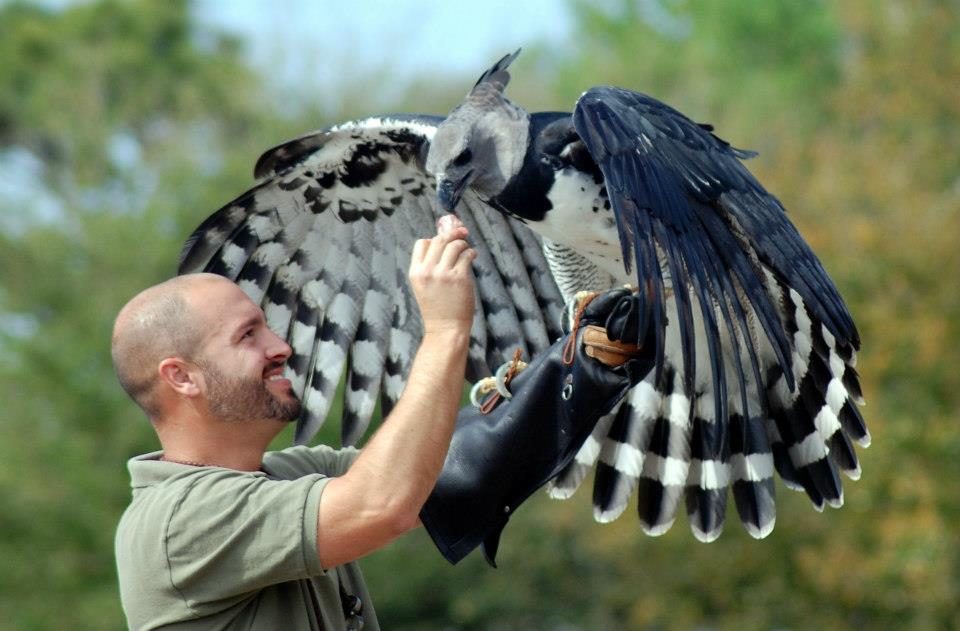The harpy eagle is the largest eagle in the world and the most powerful raptor found in the rainforest. It is also known by some as the flying wolf; being a bird of prey, it is powerful and massive. Their curved, back talons are larger than the grizzly bear’s claws at 5 inches long and they are at the top of the food chain.
Types and Species of Eagles

Harpy Eagle chick chomps on monkey
There is no official designation for the different types of eagles, but it helps when they are sorted into different unofficial classifications based on the prey they prefer or their similarities to other raptors:
- Fish-Eagles
- Hawk-Eagles and Buzzard-Eagles
- Snake-Eagles and Serpent-Eagles.
There are more than 60 different species of eagles in the world; the harpy eagle is the heaviest of the eagle species.
Greek Mythology of the name Harpy
 In Greek mythology, a harpy was a half-human and half-bird personification of storm winds. They were generally depicted as birds with the heads of maidens, faces pale with hunger and long claws on their hands. To depict the harpies, pottery art featured beautiful women with wings.
In Greek mythology, a harpy was a half-human and half-bird personification of storm winds. They were generally depicted as birds with the heads of maidens, faces pale with hunger and long claws on their hands. To depict the harpies, pottery art featured beautiful women with wings.
Definition of Harpy: A rapacious monster described as having a woman’s head and body and a bird’s wings and claws or depicted as a bird of prey with a woman’s face.
Description of the Harpy Eagle
The harpy eagle’s upper side is covered with slate-black feathers, as for the underside it is mostly white, except for the feathered tarsi which are striped black. They have a pale gray head, crowned with a double crest and a broad black band across the upper breast; the broad black band separates the harpy’s gray head from its white belly. The tail of the harpy is a unique one, it is black with three gray bands on the upper side while the underside is black with three white bands.
Scientific Classification of the Harpy Eagle
Harpy Eagle – Harpia harpyja (Scientific name)
Kingdom: Animalia
Phylum: Chordata
Class: Aves
Order: Accipitriformes
Family: Accipitridae
Subfamily: Harpiinae
Genus: Harpia
Vieillot, 1816
Species: H. harpyja
Did You know? Deforestation and shooting are the two main threats to the survival of Harpy Eagles.
The Calls of the Harpy Eagles (Vocalizations)
“Wheeeeeeeeee-wheeeeeee-wheeeeeeeee…” This describes the calls of an incubating male; a wispy screaming or wailing. This call would be repeated in a series of five to seven calls in succession; most calls are given at or near the nest, where adults give a penetrating, weak, melancholy scream. The female answers the male with calls that are similar, although at a different pitch – a lower pitch.
“Wheeeeeeee…” This describes a shorter call for the incubating female after she has fasted for 4-5 days and it is repeated for 9-12 times.
“Chi-chi-chi…chi-chi-chi-chi…” This describes the calls of the hatchlings/nestlings; apparently this is an alarm in response to rain or direct sunlight.
Rapid chirps, goose-like calls, and occasional sharp screams describes the call of the males as they approach the nest with food.
Diet and Prey of the Harpy Eagle
 Being a carnivorous bird of the rain forest, the harpy eagle preys primarily on tree-dwelling mammals like sloths, monkeys, and opossums. They will occasionally prey on other birds like macaws, and on reptiles like iguanas. Females generally target larger prey because of their size, leaving smaller prey for the males. Harpy eagles are apex predators – they’re threatened by no creatures other than humans.
Being a carnivorous bird of the rain forest, the harpy eagle preys primarily on tree-dwelling mammals like sloths, monkeys, and opossums. They will occasionally prey on other birds like macaws, and on reptiles like iguanas. Females generally target larger prey because of their size, leaving smaller prey for the males. Harpy eagles are apex predators – they’re threatened by no creatures other than humans.
Note: The female harpy eagle is larger than the male harpy eagle. As such, the females prey on larger animals and the males on smaller.
Habitat of the Harpy Eagle
The harpy eagles live in the rainforests of Central and South America. Within the tropical lowland rainforest, they hunt in the canopy or sometimes on the ground, and perch on emergent trees looking for prey. They prefer large expanses of uninterrupted forest and spend the majority of their time in the forest canopy. They are rarely seen flying over the canopy or in open spaces.
Tip: Harpy Eagles use their large strong claws to crush the skull of its prey, delivering an instant death to its victim.
Breeding and Reproduction of the Harpy Eagle
The harpy eagles mate for life; once they find a mate, they start looking for suitable nesting sites. Some harpy eagle pairs can make several nests in their lifetime while some prefer to repair and reuse the same nest again and again. When the nest is finished they copulate and, in a few days later, the female lays 2 large pale white colored eggs. Incubation begins by both parents with most responsibility being on the female and lasts up to 55 days; two eggs are laid, but once the first egg hatches, the remaining egg is ignored and will not hatch. When the chick is 36 days old it can stand and walk awkwardly, it then fledges at the age of 6 months but the parents continue to feed it for the next 6-10 months.
Why does the female lay two eggs?
The second egg acts as an insurance policy just in case there is something wrong with the first egg. If the first egg fails to hatch, the second egg has a decent chance of hatching, saving the parents the need to start over with a new egg!
The Harpy Eagles
Young harpy eagles reach sexual maturity between the ages of 4 and 5 and the female only reproduces every two to three years. They can grow to 36-40 inches; females weigh between 13 to 20 pounds and males weigh between 9 and 11 pounds. Their wings are relatively short; this enables them to maneuver through thick-forested surroundings. As for their talons, it is the largest of any living eagle and have been recorded as lifting prey up to equal their own body weight. Many tours are arranged in Guyana to see the great giant harpy eagles; many people are left in awe and amazing when they see this beautiful creature – the largest eagle in the world!
Article references:
- https://a-z-animals.com/animals/eagle/
- https://en.wikipedia.org/wiki/Harpy
- https://wilderness-explorers.com/guyana/itineraries/harpy-eagle-and-the-guianan-cockoftherock/
- http://www.andeantrails.co.uk/guyana-harpy-eagle-bird-watching-spotting-holidays
- https://neotropical.birds.cornell.edu/Species-Account/nb/species/hareag1/sounds
- https://animals.mom.me/harpy-eagle-diet-7239.html
- http://www.pbs.org/wnet/nature/jungle-eagle-harpy-eagle-fact-sheet/7263/
- https://www.reddit.com/r/natureismetal/comments/77ct1e/harpy_eagle_chick_chomps_on_monkey_hand/








2 Comments